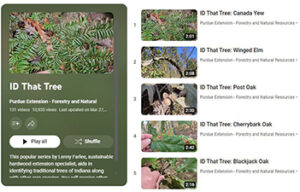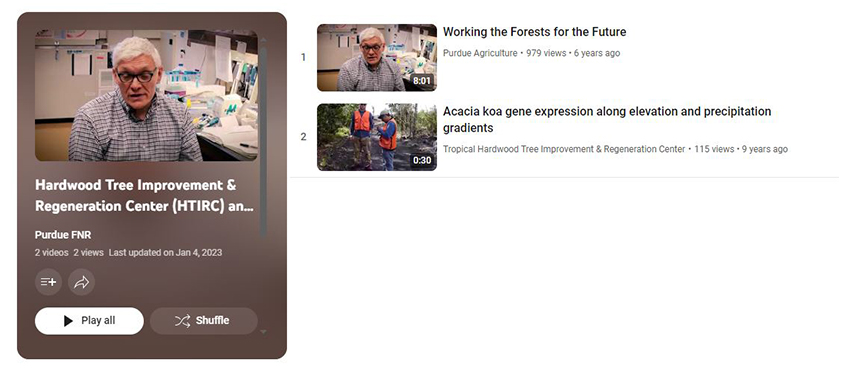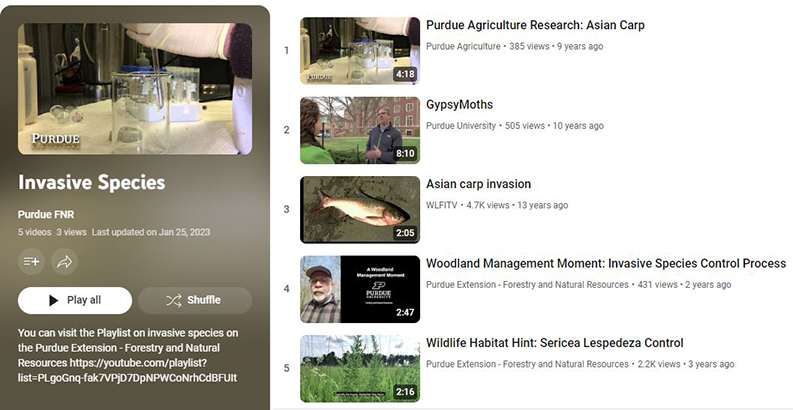For the full list of FNR publications and videos view: Click Here
- ID That Tree
- Woodland Management Moment
- Woodland Stewardship for Landowners
- Invasive Plant Species
- Woodland Management Videos and Webinars

The ID That Tree video series provides over 120 videos outlining identification characteristics for many native Indiana trees and shrubs, as well as several commonly encountered invasive trees and shrubs.
Woodland Management Moment: Crop Tree Release
In this episode of A Woodland Management Moment, Purdue Extension forester Lenny Farlee talks about crop tree release, the process of selecting timber crop trees that help meet your management objectives and managing the area around them in order to allow your selected trees to thrive in the stand. Woodland Management Moment: Crop Tree Release
Woodland Management Moment: Direct Seeding
In this episode of A Woodland Management Moment, Purdue Extension forester Lenny Farlee talks about how you can use nuts and seeds left dropped by existing trees, from walnuts to oaks and hickories, to establish new seedlings in other areas of your landscape through a process called direct seeding. Woodland Management Moment: Direct Seeding
Woodland Management Moment: Cutting Tools
In this episode of A Woodland Management Moment, Purdue Extension forester Lenny Farlee talks about a variety of hand tools you can use to assist with invasive species control and timber stand improvement on your property if you choose not to use power tools.
Woodland Management Moment: Cutting Tools
Woodland Management Moment: Cutting Tools
Woodland Management Moment: Forest Understory
In this episode of A Woodland Management Moment, Purdue Extension forester Lenny Farlee shares about some of the spring ephemeral plants, as well as shrubs, trees and even invasive species you may find in the forest understory. Woodland Management Moment: Forest Undestory
Woodland Management Moment: Asian Bush Honeysuckle
Purdue Extension forester Lenny Farlee talks about the Asian Bush Honeysuckle, an invasive species, including how you can identify it and get rid of it off of your property. Woodland Management Moment: Asian Bush Honeysuckle
Woodland Management Moment: Forest Openings
Do you need to open your woodlands in order to grow new species of trees/shrubs that need extra sunlight or to make for a better wildlife habitat? In the Woodland Management Moment, Purdue Extension forester Lenny Farlee talks about creating forest openings. Woodland Management Moment: Forest Openings
Woodland Management Moment: Against Invasives
In this Woodland Management Moment episode, Purdue Extension Forester Lenny Farlee talks about the importance of woodland management when it comes to invasive species. Woodland Management Moment: Against Invasives
Woodland Management Moment: Garlic Mustard
Garlic mustard is an invasive herbaceous plant that is shade tolerant and can invade out forest under stories. In its second growing season it produces a flower which releases many seeds. This video will share what options we have to help control it. Woodland Management Moment: Garlic Mustard
Woodland Management Moment: Grape Vine
As you decide best management practices for your woodlands, this short video shares how native grape vine can be a positive addition or a detriment depending on your goals. Woodland Management Moment: Grape Vine
Woodland Management Moment: Property Line
Marking your property line can ensure you are receiving the full benefit of the property you own. Lenny Farlee, Purdue Extension forester, shares a new inexpensive way to mark your property line and has the same force of the law as no trespassing signs have. Woodland Management Moment: Property Line
Woodland Management Moment: Deer Fencing
With high deer populations around forest land, it can be difficult to get hardwood seedlings established. Learn how to protect your newly planted seedlings from browse by white-tailed deer. Woodland Management Moment: Deer Fencing
Woodland Management Moment: Invasive Species Control Process
In this episode of A Woodland Management Moment, Purdue Extension forester Lenny Farlee talks about the process of invasive species control in woodland areas from the combination of various treatment methods to the timing of those treatments. Woodland Management Moment: Invasive Species Control Process
Check out the HTIRC Playlist on the FNR YouTube Channel

Woodland Stewardship for Landowners: Regeneration Openings
A variety of different types of regeneration openings can be created on properties to provide different structures and species of plants that are suitable to a wide variety of wildlife species. In this episode of Woodland Stewardship for Landowners, Purdue Extension forester Lenny Farlee talks about two types of regeneration openings – Clearcuts and shelterwoods. These two techniques produce an even-aged forest, where all the plants regenerating in that area are approximately of the same age. Woodland Stewardship for Landowners: Regeneration Openings
Woodland Stewardship for Landowners: Equip (FNR 587 WV)
The Environmental Quality Incentives Program (EQIP) is a cost-share program administered through the United States Department of Agriculture (USDA) that helps woodland owners remove invasive plants from the landscape, and in turn, creates a more natural forest ecosystem. Woodland Stewardship for Landowners: Equip
Woodlands Stewardship for Landowners: Common Buckthorn (FNR 588 WV)
Native to Eurasia, common buckthorn was introduced into the United States as an ornamental plant but has since invaded our woodlands as an invasive plant. Common buckthorn is becoming more common in Indiana.
Woodlands Stewardship for Landowners: Common Buckthorn
Woodlands Stewardship for Landowners: Common Buckthorn
Woodland Stewardship for Landowners: Japanese Barberry (FNR 590 WV)
Japanese barberry is an invasive plant that is originally from Japan but has been introduced into the United States as an ornamental plant. Woodland Stewardship for Landowners: Japanese Barberry
Woodland Stewardship for Landowners: Autumn Olive (FNR 586 WV)
Autumn-olive is an invasive plant that is originally from Asia but has been introduced into the United States for erosion control, and wildlife food and cover. Woodland Stewardship for Landowners: Autumn Olive
Woodland Stewardship for Landowners: Privet (FNR 591 WV)
A variety of privets have been introduced into the United States from China, Europe, and North Africa. Privet has been used as an ornamental plant, particularly as a hedgerow plant, but has since became an invasive species across the landscape. Woodland Stewardship for Landowners: Privet
Woodland Stewardship for Landowners: Managing Deer Damage to Young Trees
Browsing by deer on planted and naturally regenerated hardwood seedlings is one of the greatest obstacles to seedling establishment in many parts of the central hardwood region. In this Woodland Stewardship For Landowners, Purdue Wildlife Extension Specialist Brian MacGowan talks about different types of deer damage and how landowners could mitigate the damage. Woodland Stewardship for Landowners: Managing Deer Damage to Young Trees
FNR Ask the Expert: Invasive Plant Species
Purdue extension forester Lenny Farlee and extension specialist Liz Jackson share about invasive plant species identification, reporting and control techniques in this Facebook LIVE Q&A from June 4, 2020.
FNR Ask the Expert: Invasive Plant Species
FNR Ask the Expert: Invasive Plant Species
Invasive Plant Species: Oriental Bittersweet FNR-522-W
Learn about this invasive vine brought over from Asia in the 1860’s – oriental bittersweet. The vines and red colorful fruits are often used for wreaths and other home décor arrangements. This video will share the vines characteristics and the effect it has on forests, along with alternative plants to grow instead. Invasive Plant Species: Oriental Bittersweet FNR-522-W
Invasive Plant Species: Wintercreeper FNR-524-WV
Learn how this groundcover has creeped into our forests. This video shares its characteristics, its effect on forests, and ultimately alternative plants to grow instead. Invasive Plant Species: Wintercreeper FNR-524-WV
Invasive Plants Threaten Our Forests Part 1: Invasive Plant Species Identification
Purdue Extension forester Lenny Farlee talks about identifying invasive plant species in this webinar. Please complete the following survey after watching this video: Qualtrics Survey.
YouTube: Invasive Plants Threaten Our Forests Part 1: Invasive Plant Species Identification
YouTube: Invasive Plants Threaten Our Forests Part 1: Invasive Plant Species Identification
Invasive Plants Threaten Our Forests Part 2: Control and Management
In this webinar Purdue Extension forester Lenny Farlee talks about methods of controlling invasive plant species which includes: preventing invasions, early detection and rapid response, control techniques, accessing resources and assistance. Please complete the following survey after watching the video: Qualtrics Survey. For more videos subscribe to our Purdue-Forestry and Natural Resources channel: FNR YouTube Channel. For more resources including free downloads of publications, apps, workshops and events visit our Purdue Extension-FNR website: FNR Extension Website
YouTube: Invasive Plants Threaten Our Forests Part 2: Control and Management
YouTube: Invasive Plants Threaten Our Forests Part 2: Control and Management
Asian Bush Honeysuckle
Lenny Farlee, Sustaining Hardwood Extension Specialist, describes invasive plant, the Asian Bush Honeysuckle. Asian Bush Honeysuckle
Multiflora Rose
Lenny Farlee, Sustaining Hardwood Extension Specialist, describes the invasive species Multiflora Rose. Multiflora Rose
FNR-582-WV Burning Bush
Specialist from Purdue Extension-Forestry and Natural Resources describe the invasive species Burning Bush and what we can do to stop the spread of the species in our forest. Specialist include: Lenny Farlee, Sustainable Hardwood Extension Specialist, lfarlee@purdue.edu, and Don Carlson, Forester and Extension Specialist, carlsode@purdue.edu.
FNR-582-WV Burning Bush
FNR-582-WV Burning Bush
For more about Invasive Species, please check out the playlist on Purdue FNR YouTube

Ask The Expert: Cicada Emergence
Join exotic forest pest educator Elizabeth Barnes, Purdue extension wildlife specialist Jarred Brooke and Purdue extension forester Lenny Farlee and learn all about the Brood X cicada emergence expected in late spring 2021. This episode of Ask the Expert originally aired live on Facebook on April 29, 2021. Ask The Expert: Cicada Emergence
FNR Ask An Expert: Fall Happenings
Join Purdue Extension forester Lenny Farlee and extension wildlife
specialist Brian MacGowan as they talk all things fall. This episode of Ask the Expert covers everything from the change in fall foliage to invasive species identification and control, fall foods for humans and wildlife, habitat prep and management and planning ahead for spring plantings. FNR Ask An Expert: Fall Happenings
specialist Brian MacGowan as they talk all things fall. This episode of Ask the Expert covers everything from the change in fall foliage to invasive species identification and control, fall foods for humans and wildlife, habitat prep and management and planning ahead for spring plantings. FNR Ask An Expert: Fall Happenings
Ask The Expert: Holidays in the Wild
Join Purdue Extension forester Lenny Farlee and wildlife specialist Brian MacGowan as they help you prepare for the holidays while keeping your family and local wildlife safe. We’ll discuss everything from how to choose and care for a real Christmas tree as well as what to do with it after the season and also how to make wildlife/nature-friendly decorations. Topics Included: – What can I do with my tree after Christmas that would benefit wildlife? – Are artificial structures legal in Indiana lakes? – What types of items can I collect from the wild for holiday decorations? – How do I do it in an environmentally responsible way? – Are there some things I shouldn’t or can’t collect? – What outdoor holiday decorations can benefit wildlife? – How do I make it last longer? – Can I avoid problems with non-target wildlife? Ask The Expert: Holidays in the Wild
Practical Woodlot Management Before, During and After EAB
Join Lenny Farlee along with USDA Forest Service, Michigan State University, and Ohio State University for a presentation on practical woodlot management in Emerald Ash Borer University.
Purdue Extension – FNR: Ask the Expert
Join Jarred Brooke, Rod Williams, Lenny Farlee, Mitch Zischke, and Lindsey Purcell as they answer your questions about woodlands, forests, trees, wildlife, ponds, and invasive species.
Purdue Extension – FNR: Ask the Expert
Purdue Extension – FNR: Ask the Expert
Ask the Walnut Council Experts Q and A, July 31, 2020: Walnut Council Webinar
In this video, hosted by Walnut Council, Inc., Steve Felt, of Illinois DNR, Lenny Farlee, hardwood extension specialist with Purdue University, and Dave Boyt, Missouri sawmill owner and landowner, answer questions from the audience about hardwood management and about growing black walnut (Juglans nigra). Ask the Walnut Council Experts Q and A, July 31, 2020: Walnut Council Webinar
Fall Color Pigments
Several things come into play when it comes to determining the colors that we find on leaves of our trees. In this video we will talk about the several pigments that are found in trees and what changes from summer to fall that brings us the bright colors on leaves. Fall Color Pigments
FNR Ask the Expert: Planning and Resources for Conservation Tree Planting
Join Purdue Extension forester Lenny Farlee and Dr. Carrie Pike, a forest regeneration specialist with the USDA Forest Service, as they share about conservation tree planting, what species are available to plant, where to get them and more. FNR Ask the Expert: Planning and Resources for Conservation Tree Planting
Woodlands Management Webinar: Healthy Woodlands
Purdue Extension forester Lenny Farlee talks about what woodland management means, defining your goals and objectives, invasive species control and timber stand improvement (TSI) and finding appropriate professional help in this webinar. Note: evaluation slide at the end is incorrect. Follow this link to proper evaluation: Qualtrics Survey. Find the PowerPoint presentation for print on our website: PowerPoint Presentation. For more resources visit: FNR Extension Website
YouTube: Woodlands Management Webinar: Healthy Woodlands
YouTube: Woodlands Management Webinar: Healthy Woodlands
A Woodland Management Webinar: Selling Timber
Join Purdue Extension forester Lenny Farlee as he explains: – Why should I sell timber? – Getting help from a professional forester – Common concerns when selling timber – Best management practices loggers use – Types of tree sales, pros and cons of each – Tx considerations – Potential cost sharing opportunities through USDA – Where to get additional information. Follow this link to provide feedback on this video, Qualtrics Survey YouTube: A Woodland Management Webinar: Selling Timber
FNR Ask the Expert: Pests in Your Woods
Join Purdue Extension specialist Liz Jackson and Elizabeth Barnes, from the department of entomology, as they share about how to recognize current and potential insect pests and diseases that may be affecting the trees in your woods as well as your plants.
FNR Ask the Expert: Pests in Your Woods
FNR Ask the Expert: Pests in Your Woods
What Does Purdue Extension-Forestry and Natural Resources Offer?
Take a virtual tour with us and receive a quick peek of our publications, Got Nature? Blogs and videos.
What Does Purdue Extension-Forestry and Natural Resources Offer?
What Does Purdue Extension-Forestry and Natural Resources Offer?
